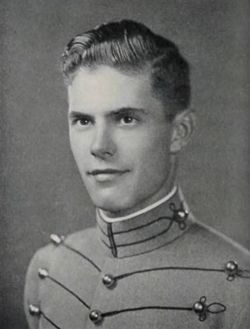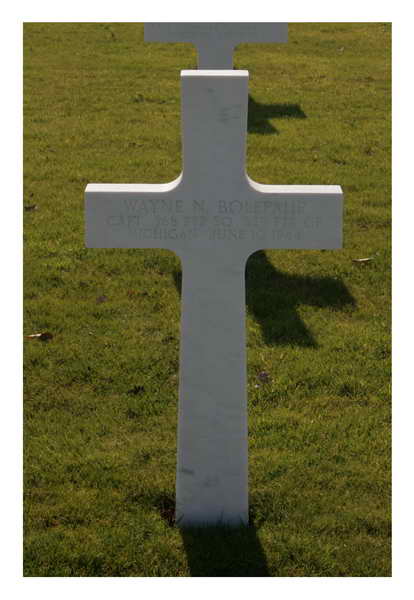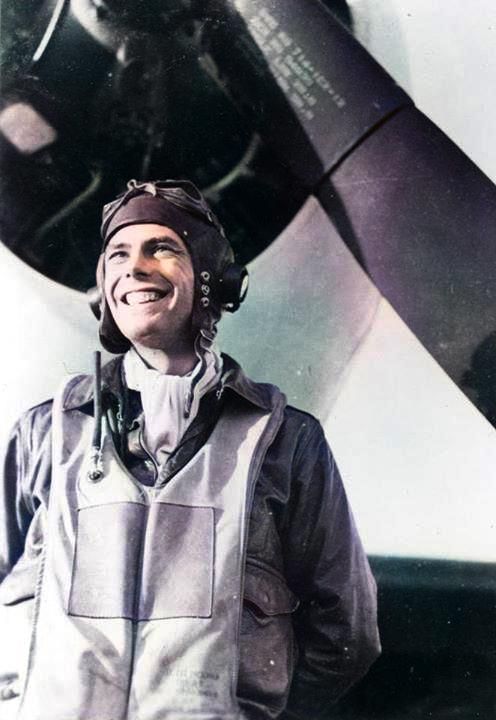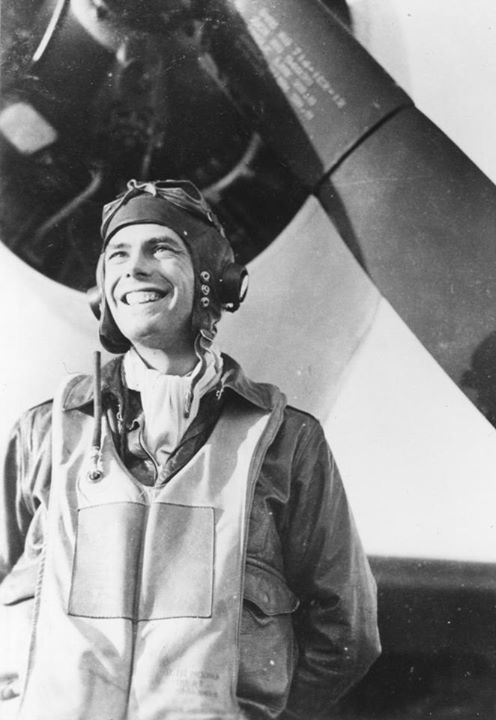USAAF WORLD WAR II
Pilot Captain Wayne N. Bolefahr KIA
United States Military Academy Class of 1942
368th Fighter Squadron, 359th Fighter Group
Hometown: Kansas City, Missouri
Service# O-024907
Awards: Distinguished Service Cross, Distinguished Flying Cross with Oak Leaf Cluster, and Air Medal with four Oak Leaf Clusters
MACR 1964
Target: Recon in support of DDay
Mission Date: 10-Jun-44
Serial Number: #43-24786 CS-
Aircraft Model P-51
Aircraft Letter:
Aircraft Name:
Location: Marshalling yard on the Antwerp-Roosendaal railway,
Cause: flak
Captain Wayne Bolefahr was born in Eureka, Kansas on February 7, 1920. He was brought up in Kansas City, Missouri. At the age of seventeen he graduated from Southwest High School where he had been very active in track. His family moved to Grosse Pointe, Michigan at that time, and Wayne attended the University of Detroit for one year. He then entered West Point in 1938.
After graduating from the Academy in May, 1942, he entered the Air Corps and was stationed at Pine Bluff, Arkansas for his elementary training. He received his basic training at Randolph Field and was then transferred to Foster Field, Texas. It was there on December 13, 1942 that he received his wings. In January, 1943, Wayne was made a First Lieutenant while he was stationed at Moore Field, Mission, Texas for specialized training. At Westover Field, Massachusetts he was assigned to the 359th Fighter Group. Subsequently, he was made a flight leader in the 368th Fighter Squadron. During the time that the squadron was being formed and trained, Wayne was stationed at Grenier Field, New Hampshire; Republic Field, New York; and again at Westover Field, Massachusetts. In August of 1943 he was promoted to Captain.
The group was sent overseas in October, 1943. From October until his death in June he was stationed at an air base in England. Except for one week's vacation, he saw continuous action, sometimes going on two missions in one day. The 359th Fighter Group made itself famous, with pursuit pilots like Wayne, flying P-47 Thunderbolts and then P-51 Mustangs. He received the Air Medal with four clusters and the Distinguished Flying Cross with one cluster, for the destruction of two enemy aircraft, damage to a third, and other meritorious service.
Wayne was posthumously awarded the Purple Heart and the Distinguished Service Cross with the following citation:
"For extreme gallantry in action at known risk of his life above and beyond the call of duty.
"On 10 June 1944, Captain Bolefahr was assigned to lead the second section of a P-51 Fighter Squadron supporting four Photo Reconnaissance Unit Aircraft, ordered to secure photographs of Important military installations at Antwerp, Belgium.
"Owing to the nature of the targets it was necessary that the photographs be taken from an extremely low altitude. Several previous attempts to secure pictures there had resulted in heavy casualties, due to the very intense and accurate light calibre flak in the area.
"The briefed plan of the mission was to cross the enemy coast at Breskins at 1,500 feet, then hit the deck and proceed to the vicinity of Antwerp, using a canal as a landmark to the target area.
"Light calibre flak positions, especially effective against low-flying aircraft, were known to exist all along the course from landfall Inward, and to be heavily concentrated in the target area. This Intense flak made it difficult for the P.R.U. aircraft to find the target, and a period of approximately twenty minutes of flying at tree-top and power-line level was spent in the area before the target, a marshalling yard on the Antwerp-Roosendaal railway, was located.
"With the whole section flying close escort and blanketing the flak positions with a steady stream of fire, the P.R.U. aircraft made several runs on the target, but each approach was driven off by the concentrated ground defenses.
"Captain Bolefahr sensed at once that as long as the many guns were directing their fire at the reconnaissance planes they would not be able to maneuver Into a position favorable for taking the photos.
"With utter disregard for his own personal safety, and in full knowledge of the fact that his chances of escaping the resultant fire were negligible, he pulled up to a height of 100 feet, flying directly towards the marshalling yard's main gun positions.
"Captain Bolefahr's tactic of making himself the most obvious target in the area succeeded in diverting the fire from the P.R.U. planes to his own, and the former were consequently able to accomplish their mission. But by so doing he made his aircraft an easy target and it received many vital hits. The plane crashed through a row of trees, disintegrating as it struck the ground, Captain Bolefahr doubtless perishing in the wreckage.
"The coolness and daring with which Captain Bolefahr executed this feat, and his outstanding gallantry in the face of overwhelming odds, were an inspiration to his fellow flyers.
"His action reflects the greatest credit upon himself and the Armed Forces of the United States."
In a magazine published in Norwich, England for the Eighth Air Force, Wayne was described in an article entitled No Braver Deed, "Though daring deeds were the order of the day, no single act of heroism in the annals of the 359th surpasses the last flight of Capt. Wayne N. Bolefahr on 10 June 1944."
Capt. Wayne N. Bolefahr was reported missing for six months and then reported killed in action in December, 1944. He is survived by his parents; his sister, his wife, the former Ruth Oliver; and one son.
Wayne Norbury Bolefahr
DATE OF BIRTH: February 7, 1920
PLACE OF BIRTH:
Eureka, Kansas
HOME OF RECORD:
Wayne County, Michigan
Wayne Bolefahr graduated from the U.S. Military Academy at West Point, Class of 1942. He was credited with a total of TWO aerial victories in World War II before he was himself, killed in action.
Distinguished Service Cross
AWARDED FOR ACTIONS
DURING World War II
Service: Army Air Forces
Battalion: 368th Fighter Squadron
Division: 8th Air Force
GENERAL ORDERS:
Headquarters, U.S. Strategic Forces in Europe, General Orders No. 87 (November 2, 1944)
CITATION:
The President of the United States of America, authorized by Act of Congress July 9, 1918, takes pride in presenting the Distinguished Service Cross (Posthumously) to Captain (Air Corps) Wayne Norbury Bolefahr (ASN: 0-24907), United States Army Air Forces, for extraordinary heroism in connection with military operations against an armed enemy while serving as Pilot of a P-51 Fighter Airplane in the 368th Fighter Squadron, 359th Fighter Group, EIGHTH Air Force, in aerial combat against enemy forces on 10 June 1944, in the European Theater of Operations. Leading a P-51 fighter section in support of four PRU airplanes, Captain Bolefahr was briefed to stay clear of the intense ground flak which had prevented, with casualties, other attempts to get low altitude pictures in the area. Discovering the enemy fire to be so intense that the PRU airplanes were repeatedly driven off their target, after 20 minutes flight in the area at tree top level, Captain Bolefahr voluntarily pulled up to 100 feet and strafed the defending gun positions, thereby flying straight into their line of fire in his determination to wipe out enough positions to permit the pictures to be taken. Warned at briefing that any such fighter intervention probably would be fatal, on the basis of previous PRU losses there, he made his strafing run with impeccable cool skill, neutralizing several guns. As a result of the action planes were able to come in and obtain the ordered pictures. Captain Bolefahr's airplane flamed under many direct flak hits, crashed through trees, and disintegrated on the ground. His initiative in the face of overwhelming odds and his sacrificial resolution made a success of a hazardous mission. This action, an inspiration to his fellow flyers, reflects the highest credit upon himself and the Armed Forces of the United States.
USAAF WORLD WAR II
Pilot Captain Wayne N. Bolefahr KIA
United States Military Academy Class of 1942
368th Fighter Squadron, 359th Fighter Group
Hometown: Kansas City, Missouri
Service# O-024907
Awards: Distinguished Service Cross, Distinguished Flying Cross with Oak Leaf Cluster, and Air Medal with four Oak Leaf Clusters
MACR 1964
Target: Recon in support of DDay
Mission Date: 10-Jun-44
Serial Number: #43-24786 CS-
Aircraft Model P-51
Aircraft Letter:
Aircraft Name:
Location: Marshalling yard on the Antwerp-Roosendaal railway,
Cause: flak
Captain Wayne Bolefahr was born in Eureka, Kansas on February 7, 1920. He was brought up in Kansas City, Missouri. At the age of seventeen he graduated from Southwest High School where he had been very active in track. His family moved to Grosse Pointe, Michigan at that time, and Wayne attended the University of Detroit for one year. He then entered West Point in 1938.
After graduating from the Academy in May, 1942, he entered the Air Corps and was stationed at Pine Bluff, Arkansas for his elementary training. He received his basic training at Randolph Field and was then transferred to Foster Field, Texas. It was there on December 13, 1942 that he received his wings. In January, 1943, Wayne was made a First Lieutenant while he was stationed at Moore Field, Mission, Texas for specialized training. At Westover Field, Massachusetts he was assigned to the 359th Fighter Group. Subsequently, he was made a flight leader in the 368th Fighter Squadron. During the time that the squadron was being formed and trained, Wayne was stationed at Grenier Field, New Hampshire; Republic Field, New York; and again at Westover Field, Massachusetts. In August of 1943 he was promoted to Captain.
The group was sent overseas in October, 1943. From October until his death in June he was stationed at an air base in England. Except for one week's vacation, he saw continuous action, sometimes going on two missions in one day. The 359th Fighter Group made itself famous, with pursuit pilots like Wayne, flying P-47 Thunderbolts and then P-51 Mustangs. He received the Air Medal with four clusters and the Distinguished Flying Cross with one cluster, for the destruction of two enemy aircraft, damage to a third, and other meritorious service.
Wayne was posthumously awarded the Purple Heart and the Distinguished Service Cross with the following citation:
"For extreme gallantry in action at known risk of his life above and beyond the call of duty.
"On 10 June 1944, Captain Bolefahr was assigned to lead the second section of a P-51 Fighter Squadron supporting four Photo Reconnaissance Unit Aircraft, ordered to secure photographs of Important military installations at Antwerp, Belgium.
"Owing to the nature of the targets it was necessary that the photographs be taken from an extremely low altitude. Several previous attempts to secure pictures there had resulted in heavy casualties, due to the very intense and accurate light calibre flak in the area.
"The briefed plan of the mission was to cross the enemy coast at Breskins at 1,500 feet, then hit the deck and proceed to the vicinity of Antwerp, using a canal as a landmark to the target area.
"Light calibre flak positions, especially effective against low-flying aircraft, were known to exist all along the course from landfall Inward, and to be heavily concentrated in the target area. This Intense flak made it difficult for the P.R.U. aircraft to find the target, and a period of approximately twenty minutes of flying at tree-top and power-line level was spent in the area before the target, a marshalling yard on the Antwerp-Roosendaal railway, was located.
"With the whole section flying close escort and blanketing the flak positions with a steady stream of fire, the P.R.U. aircraft made several runs on the target, but each approach was driven off by the concentrated ground defenses.
"Captain Bolefahr sensed at once that as long as the many guns were directing their fire at the reconnaissance planes they would not be able to maneuver Into a position favorable for taking the photos.
"With utter disregard for his own personal safety, and in full knowledge of the fact that his chances of escaping the resultant fire were negligible, he pulled up to a height of 100 feet, flying directly towards the marshalling yard's main gun positions.
"Captain Bolefahr's tactic of making himself the most obvious target in the area succeeded in diverting the fire from the P.R.U. planes to his own, and the former were consequently able to accomplish their mission. But by so doing he made his aircraft an easy target and it received many vital hits. The plane crashed through a row of trees, disintegrating as it struck the ground, Captain Bolefahr doubtless perishing in the wreckage.
"The coolness and daring with which Captain Bolefahr executed this feat, and his outstanding gallantry in the face of overwhelming odds, were an inspiration to his fellow flyers.
"His action reflects the greatest credit upon himself and the Armed Forces of the United States."
In a magazine published in Norwich, England for the Eighth Air Force, Wayne was described in an article entitled No Braver Deed, "Though daring deeds were the order of the day, no single act of heroism in the annals of the 359th surpasses the last flight of Capt. Wayne N. Bolefahr on 10 June 1944."
Capt. Wayne N. Bolefahr was reported missing for six months and then reported killed in action in December, 1944. He is survived by his parents; his sister, his wife, the former Ruth Oliver; and one son.
Wayne Norbury Bolefahr
DATE OF BIRTH: February 7, 1920
PLACE OF BIRTH:
Eureka, Kansas
HOME OF RECORD:
Wayne County, Michigan
Wayne Bolefahr graduated from the U.S. Military Academy at West Point, Class of 1942. He was credited with a total of TWO aerial victories in World War II before he was himself, killed in action.
Distinguished Service Cross
AWARDED FOR ACTIONS
DURING World War II
Service: Army Air Forces
Battalion: 368th Fighter Squadron
Division: 8th Air Force
GENERAL ORDERS:
Headquarters, U.S. Strategic Forces in Europe, General Orders No. 87 (November 2, 1944)
CITATION:
The President of the United States of America, authorized by Act of Congress July 9, 1918, takes pride in presenting the Distinguished Service Cross (Posthumously) to Captain (Air Corps) Wayne Norbury Bolefahr (ASN: 0-24907), United States Army Air Forces, for extraordinary heroism in connection with military operations against an armed enemy while serving as Pilot of a P-51 Fighter Airplane in the 368th Fighter Squadron, 359th Fighter Group, EIGHTH Air Force, in aerial combat against enemy forces on 10 June 1944, in the European Theater of Operations. Leading a P-51 fighter section in support of four PRU airplanes, Captain Bolefahr was briefed to stay clear of the intense ground flak which had prevented, with casualties, other attempts to get low altitude pictures in the area. Discovering the enemy fire to be so intense that the PRU airplanes were repeatedly driven off their target, after 20 minutes flight in the area at tree top level, Captain Bolefahr voluntarily pulled up to 100 feet and strafed the defending gun positions, thereby flying straight into their line of fire in his determination to wipe out enough positions to permit the pictures to be taken. Warned at briefing that any such fighter intervention probably would be fatal, on the basis of previous PRU losses there, he made his strafing run with impeccable cool skill, neutralizing several guns. As a result of the action planes were able to come in and obtain the ordered pictures. Captain Bolefahr's airplane flamed under many direct flak hits, crashed through trees, and disintegrated on the ground. His initiative in the face of overwhelming odds and his sacrificial resolution made a success of a hazardous mission. This action, an inspiration to his fellow flyers, reflects the highest credit upon himself and the Armed Forces of the United States.
Gravesite Details
Entered the service from Michigan.
Family Members
Sponsored by Ancestry
Advertisement
Records on Ancestry
-
U.S., Newspapers.com™ Marriage Index, 1800s-2020
-
1930 United States Federal Census
-
U.S., Headstone and Interment Records for U.S., Military Cemeteries on Foreign Soil, 1942-1949
-
Kansas, U.S., Newspapers.com™ Stories and Events Index, 1800's-current
-
U.S., Select Military Registers, 1862-1985
Sponsored by Ancestry
Advertisement











